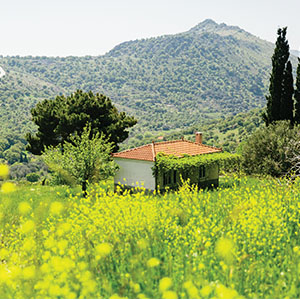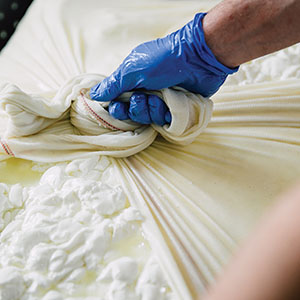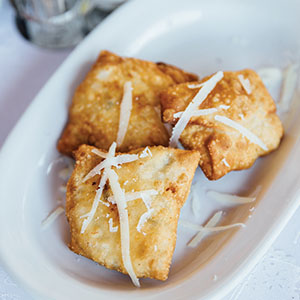Feta cheese has been a part of Greece for nearly as long as humanity itself. It comes from the very first cheese around 8,000 years ago, which was made soon after people began domesticating animals. Historians believe that milk began to ferment while being transported in the stomach of a goat or sheep. The shepherds noticed that the new product lasted much longer than fresh milk—and cheese was born.
The first written mention of Feta appears in Homer’s Odyssey, which dates from near the end of the 8th century BC. The protagonist Ulysses ventures to visit the cave of Polyphemus, also known as the Cyclops. When he arrives, he finds all the evidence of cheesemaking in action:
“We soon reached his cave, but he was out shepherding. We went inside the cave and looked around. It was astonishing—crates full of cheese, pens crammed with livestock-lambs and kids sorted into separate groups, with yearlings, older lambs and newborns each in different pens. All the sturdy buckets, pails and milking bowls were awash with whey. Next, Polyphemus curdled half the white milk, and gathered it in wicker baskets and laid it away.”

The Cyclops is the mythical grandfather of Feta cheese. Since then, this favorite has been at the center of Greek cuisine, culture and life.
The word “Feta” means slice or slab in Greek. That term originated in the 17th century—before then, Feta was just called “cheese” in Greece—and refers to the tradition of slicing up cheese and placing it in barrels, a practice that continues to this day. Brining is an essential part of what makes Feta unique. The cheese is traditionally made with sheep’s milk, although up to 30 percent of the milk can come from goats. Feta has a tangy, fresh and briny flavor and a creamy yet crumbly texture. Sheep’s milk imparts a buttery richness, and goat’s milk adds acidity.
Misunderstood
Rachel Juhl, chief educator and trainer at Brooklyn, NY-based Essex St. Cheese, has been immersed in Feta since well before the cheese importer and wholesaler launched its own Greek Feta in 2013. “It was a three-year process, which involved learning a ton and visiting many different producers,” she recalls. “It fit with our mission to find cheeses that are misunderstood in the marketplace—we find the truly authentic version.” That described Feta perfectly, a cheese that is often seen only as a vehicle for salt and texture in a salad or an omelet. Instead, Essex St. Cheese wanted to celebrate the artisanal version of one of the world’s most ancient cheeses.
That version of its Feta comes from Agra on the island of Lesbos, where it is crafted by third generation cheesemaker M. Tastanis. The Feta is made every day between mid-December and the end of July when the sheep graze on fresh grasses, herbs and wildflowers, with a combination of chilled evening milk and fresh morning milk. After the milk is pasteurized, it is cooled down, and a spoon of yogurt, a starter culture and animal rennet is added. Soon, it develops a creamy texture, and the curds are cut into cubes, salted and pressed for 30 minutes, then salted again on each side for several hours. The curds are thumb-sized, which is what allows the cheese to so easily crumble. It’s almost the exact same process that the Cyclops used thousands of years ago.

The cheesemaker controls the content of the brine, what kind and how much salt is used, and how often the brine is changed. “Salt is another ingredient that affects the flavor,” says Juhl. Tastanis changes the brine weekly so that the Feta does not sit in its own whey, as salt pulls the whey out of the cheese.
Sheree Cardoos, who now runs Cardoos McKenna Marketing in San Francisco, worked as the president of Mt Vikos for 10 years before selling the company to Blue Marble. She still works with the brand as a broker. At Mt Vikos, which sells PDO Greek Feta, the cheese come from the milk of sheep and goats (they use about 15 percent goat’s milk) that graze on fresh grasses and herbs in the mountains of Thessaly. This “gives the milk the extra wonderful flavor and quality,” according to Cardoos.
They never use add calcium chloride or whey powder, common additions to cow’s milk Feta, or use commodity milk or whey powder. Made in a traditional manner, Mt Vikos’ Feta is crafted in 20-pound rounds, then stacked five tall in a Beachwood barrel and covered with brine. The cheese is then cellared for four months, which allows the flavor to develop into something complex, robust and toothsome. “Cheese right out of the barrel is fabulous,” exclaims Cardoos. “The most delicious thing I’ve had.”
A Hard-won Fight
After 16 years of court battles with Germany and Denmark, which make their own cheese that they wanted to be able to call Feta, the European Union granted name-protected PDO (Protected Designation of Origin) status to Greek Feta in 2002. Other countries were given five years to rename their cheeses or stop production. Sometimes called “white gold,” it is one of the country’s most important exports.
“With the economic crisis, advocating for unique stories and history, instead of assuming everyone knows, became extra important for Greece,” Juhl explained. Its history, tradition and geographic location distinguish Greek Feta from its cousins around the world. “The flora really sets it apart from everywhere else in the Mediterranean,” Juhl adds. “There are more than 6,000 species of natural flora that are endemic—they only exist in Greece.”

To receive the PDO, Feta can be made in one of seven regions: specific prefectures on the mainland and the islands of the Peloponnese; Thessalia; Epirus; Macedonia; Thrace; and Lesbos. Feta is produced from breeds of sheep and goat traditionally grown and fed in these areas and whose diet is based on its natural flora. PDO Feta must be made with only sheep’s milk—and maybe some goat’s milk—rennet and salt. Feta is matured for at least 60 days and cannot contain antibiotics, preservatives, additives and/or food coloring. Cow’s milk “Feta” is often dyed to create the natural white color of sheep and goat’s milk cheese.
“Most people know Feta as the dry, salty, crumbly stuff that goes on a Greek salad,” says Cardoos. “What they’re buying, is cow’s milk domestic Feta, often pre-crumbled,” and not the real deal. As for the real thing, it’s uniquely clean, sweet-tart and full-bodied. Only about 2 percent of all Feta consumed in the United States is actually made in Greece.
Enjoying Feta
Feta is a quintessential part of life in Greece—the average Greek person consumes about 50 pounds each year, and 70 percent of the cheese Greeks eat is Feta. In the U.S., Feta is most often served in Greek salads, but that’s just the tip of the iceberg when it comes to delicious ways to enjoy the cheese. Tossed into a refreshing salad with watermelon and mint, Feta’s savory notes highlight the fresh sweetness of the fruit.
Use it as a topping for pizza or bruschetta—a pizza with fresh tomato, olives, artichokes and Feta is a guaranteed crowd-pleaser. It’s the perfect addition to meat and cheese pies, adding a great and creamy bite. Grilled veggies and Feta in foil is an excellent meatless meal or a summer side. Feta is also a good friend to eggs, whether it’s mixed into an omelet with spinach, scrambled into breakfast eggs with fresh herbs or added to a frittata.
“I love marinating Feta in good olive oil, fresh thyme, oregano and peppercorns,” Cardoos explains. “Throw that on bread, and it’s heaven.”
But the very best way to serve Feta harkens back to its name—as a slab, just as it is. “There is always a slab of Feta on the table,” Juhl says of her visits to Greece, with meals served family-style. “It goes with lamb, fresh veggies and pretty much everything.” Pair Feta with soft red wines, like Pinot Noir and Beaujolais, and crisp white wines, including Sauvignon Blanc and bubbly Cava.
Greek Baked Feta Cheese in Puff Pastry with Honey

Recipe courtesy of Sheree Cardoos
This easy-to-make appetizer of Feta enclosed in flaky puff pastry is the perfect way to kick off a dinner party.
Cook Time: 20 minutes
Total Time: 25 minutes
Serves: 2-3
Ingredients:
8 oz Feta cheese (ideally you want the Feta to be in the shape of a rectangle or square about 3 X 4 inches, so you can fold it easily)
1 sheet puff pastry cut in quarters
2 tsp honey
2 tsp of sesame seeds
1 Tbsp of milk
• Preheat oven to 350 degrees F
• Roll out the puff pastry sheet and cut into quarters.
• Place the Feta in the center of the sheet and fold the sheet over the cheese and press with fork or fingers to seal.
• Brush with the milk and sprinkle sesame seeds on top.
• Bake for about 25 minutes, until golden brown.
• Remove from oven drizzle immediately with honey. Serve warm.



